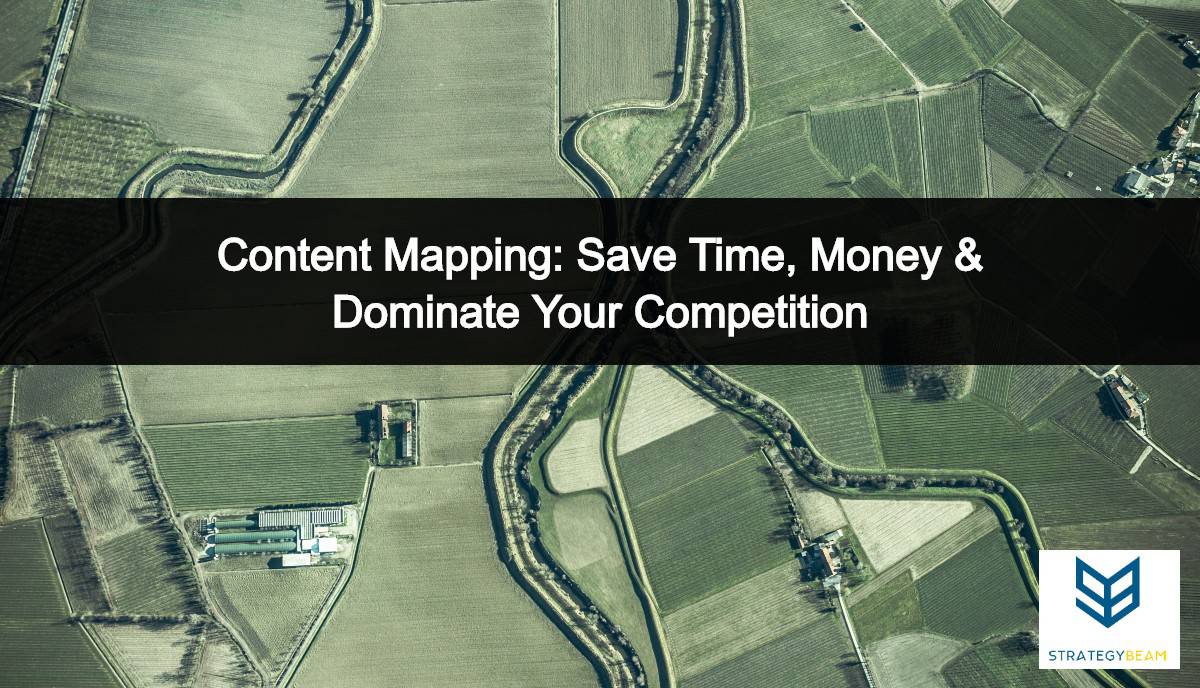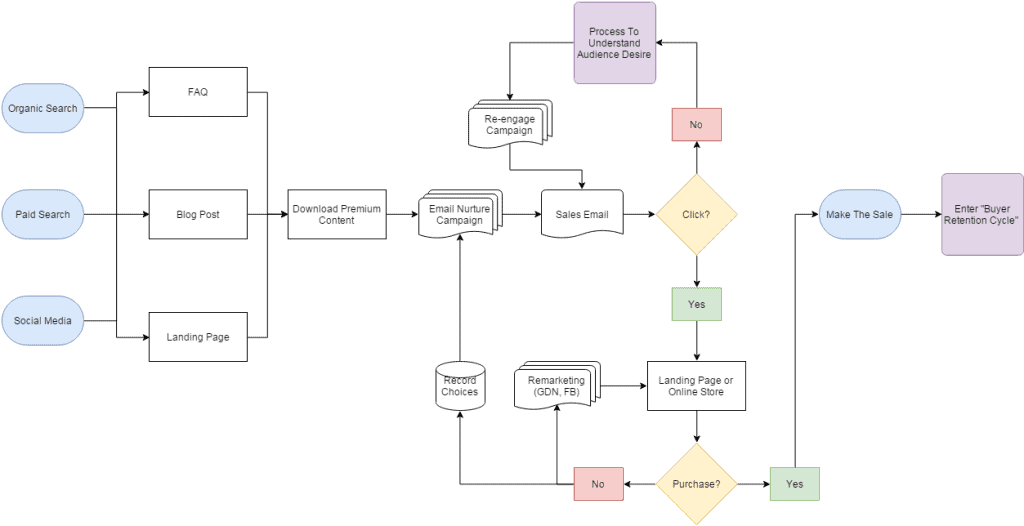
What Is Content Mapping?
A content map directs content creation because it helps create the right content to address your audience’s specific needs. Content mapping uses buyer personas and the customer journey to produce the best content types for your target audience. A content map is the top-down view of your entire marketing journey that shows you how different channels interact and how you will nurture customers throughout their customer journey.
Before we continue, let’s take a look at a simple content map example. You will see in the below content map that the map has a visual flow between different types of content based on customer actions.

You already know that every piece of new content you produce will require time, energy, and resources. This means that you should create content that will get found and resonate with the pain points that your customers have.
This visual map technique helps you organize and understand how your content interacts and determine what structure you need to support that marketing strategy.
How Does Content Mapping Help My Business?
If content is a fuel that drives a marketing strategy, then content mapping is the headlight that allows you to see what your business must do to execute a successful content strategy.
A content map provides a systematic approach to digital marketing, and this part of content marketing can help your business in several ways like:
- Save Time & Resources: A content map takes the guesswork out of digital marketing so you won’t waste time or resources on ineffective blog posts or social media posts.
- Understand Your Customers: You must understand how people look for your products and services. Use a content map to understand who your customers are and how they search for your solutions.
- Make The Right Content: Different types of content work best on different marketing channels. Content mapping helps align the right content with the right channels for your audience.
- Streamline The Buyer’s Journey: Your customers have questions and needs at each buying process stage. Content Mapping provides your business with a step-by-step guide to review and improve customer interactions across all areas of your business.
What Lifestages Should A Content Map Include?
Your customers go through different stages to research, consider, and make a final buying decision. A successful content marketing strategy requires you to build different content types based on where your customers are in the buyer’s journey.
It can be overwhelming to consider all variables at every journey stage. The content mapping process can help you understand what your customers need at each customer journey stage.
- Awareness Stage: The first step of the buyer’s decision is to realize they have a problem. This stage is usually defined with pain points and symptoms, but no action has been made to research a solution.
- Consideration Stage: The section step in the customer journey is to research ways to alleviate their pain point. At this stage, your customers understand their needs and look for a solution to their pain points.
- Decision Stage: The third stage of the customer journey is when someone has researched solutions to address their needs and is ready to purchase a solution to alleviate their needs.
Your customers go through different stages as they identify, define, and resolve pain points. Now that we have defined the different stages of the customer journey, we can move on to look at five general steps to build a great content map.
5 Steps To Start The Content Mapping Process
Follow these five steps to building a content map for your content strategy.
- Build A Buyer Persona: Buyer personas are frameworks that represent segments of your target audience. Your company will have multiple buyer personas based on demographics, behaviors, and needs.
- Review The Customer Journey: Great content marketing delivers the right content to the right people at the right time. Talk to your customer service reps and sales team to discover prospective customers’ questions and build specific content to address those questions.
- Analyze Existing Content: Look at the buyer personas you built and organize existing content to see if your company delivers the information your customers need to overcome objectives. Categorize content by the intended audience, the lifecycle stage, and the desired outcome.
- Identify Content Gaps: Once you categorize existing content, you will see gaps in the customer journey. Use this information to plan the next steps to create new content.
- New Content Mapping: Creating new content can take a lot of time and resources, so plan out the process after reviewing existing content and content gaps.
What Types Of Content Should I Have In A Content Map?
You need a content strategy based on your customers’ needs if you want to reduce wasted time and resources. This means the only way to build a successful content marketing strategy is to understand your customers’ buyer persona throughout the entire customer journey.
While there is a never-ending list of different content types at your disposal, different types of content are best used at different stages of the customer journey.
| Content Map Life Stage | Customer Decision | Types of Content |
|---|---|---|
| Awareness Stage | Identify pain points, begin research. | – SEO – Social Media – Webinars – Infographics – Remarketing – Early-Stage FAQ |
| Consideration Stage | Understand needs, researching solutions | – SEO – Case Studies – Testimonials – White Papers |
| Decision Stage | In-depth research, ready to purchase. | – Google Ads – Facebook Ads – Late-Stage FAQ – Landing Pages |
You will need to use professional copywriting services to receive tips to build amazing content that gets round and integrate that content into your content map to grow your business. Here are some content ideas to include in different stages of the buyer’s journey.
1. Awareness Stage
- SEO: Your customers are asking generic questions about their pain points. Build relevant content that speaks to the specific needs of your customers to get found in search engines. You will need to use keyword research to get each piece of content found on search engines.
- Educational Social Media Posts: Think about your customers’ social media platforms, spend time on, and build targeted content to meet their needs. You can build a social media strategy based on where your customers spend time and your business goals.
- Webinars: You can use a webinar to make a connection with prospective customers and establish the pain points and needs they have with this interactive channel.
- Infographic: An infographic is a blog post but uses images to share a message. Use infographics to reach your target audience with visual content early in the buyer’s journey’s lifecycle stages.
- Google Remarketing: Use remarketing to build your brand and engage with customers who come to your site but are not ready to buy yet. Remarketing on Google and Facebook can be an inexpensive and effective marketing strategy because as you drive more people to your site with relevant content, you will need to stay top of mind as prospective customers continue to research through the customer journey.
- Early-Stage FAQ Pages: FAQ pages are a great way to rank in Google because these pages include questions commonly asked by your customers. Use FAQ pages with high-level questions to help your customers define their problem and begin the process to find a solution.
2. Consideration Stage
- SEO: You can use SEO marketing to serve customers’ relevant content as they begin to understand their needs. Build different blog posts and specific content to keep customers moving forward to the next stage of the marketing funnel.
- Case Studies: A case study is a powerful tool because you can use this effective content to show that your business has already helped other customers with the same problems as prospective customers.
- Testimonials: People want to buy from a company that is trusted in the community. Place testimonials on sales pages to show that your products and services address specific needs.
- White Papers: White papers are in-depth descriptions of how your company helped specific customers in the past.
3. Decision Stage
- Google Ads: Google Ads marketing a great way to get in front of customers ready to buy. You can show the right message to the right people at the right time because you can bid on search terms for your customers’ specific needs.
- Facebook Ads: Similar to Google Ads, you can use Facebook ads marketing to create targeted content based on customer segmentation.
- Late-Stage FAQ Pages: At this point in the buyer’s journey, your customers are ready to purchase. You can use late-stage FAQ pages to display specific questions and answers about your products or services to help buyers overcome final objectives.
- Landing Pages: Build focused landing pages based on the specific needs of your customers. Craft landing pages with specific messaging and reduces unneeded content on these pages with clear CTAs to boost conversion rates.
Your customers have needs, and your company has an excellent opportunity to build a content strategy around their pain points.
Instead of blindly creating new content, you should develop different content types for different marketing channels to keep customers going down the buying process.
Build Targeted Content For Your Target Audience
Content mapping is an essential part of any marketing strategy. Not only will a content map help you understand your customers, but it also helps reduce the amount of time and energy needed for content marketing.
If you want to get the most out of your content, you need to think about how the content will be used and consumed. Map your content to ensure that you can reach your audience and drive more sales today!
Content Mapping FAQs
Content mapping helps you build and optimize content around your customer needs. This visual tool displays buyer personas and all stages of the customer journey.
Your content map will outline different types of content to use throughout your customer experience. You will use the content map to plan, optimize, and enhance relevant content based on customer needs.
- SEO: Use SEO practices to get your content found throughout the customer lifecycle.
- Social Media: Create educational social media posts to engage qualified leads.
- Remarketing: Engage prospective buyers after they interact with your site.
- FAQ Pages: Answer common questions throughout the buyer’s journey.
- Google & Facebook Ads: Optimize your paid search ads based on specific terms and need your customers are searching for.

